Orontid dynasty
The Orontid dynasty, also known by their native name Eruandid or Yervanduni, was a hereditary Armenian[1] dynasty and the rulers of the successor state to the Iron Age kingdom of Urartu (Ararat).[2][3] The Orontids established their supremacy over Armenia around the time of the Scythian and Median invasion in the 6th century BC.
| Orontid | |
|---|---|
| Country | Armenia |
| Founded | 6th century BC |
| Founder | Orontes I |
| Current head | Extinct |
| Final ruler | Orontes IV (Armenia) Mithrobazane II (Sophene) Antiochus IV (Commagene) |
| Titles | |
| Dissolution | 200 BC |
| Cadet branches | possibly Artaxiad Dynasty |
Members of the Orontid dynasty ruled Armenia intermittently during the period spanning the 6th century BC to at least the 2nd century BC, first as client kings or satraps of the Median and Achaemenid empires who established an independent kingdom after the collapse of the Achaemenid empire, and later as kings of Sophene and Commagene who eventually succumbed to the Roman Empire. The Orontids are the first of the three royal dynasties that successively ruled the ancient Kingdom of Armenia (321 BC–428 AD).
Historical background
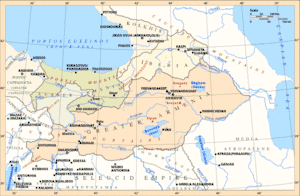
Historians state that the dynasty was of Iranian origin,[4][5][6][7][8][9][10] and suggest (albeit not clearly) that it held dynastic familial linkages to the ruling Achaemenid dynasty.[11][12] Throughout their existence, the Orontids stressed their lineage from the Achaemenids in order to strengthen their political legitimacy.[13]
According to Razmik Panossian, the Yervandunis probably had marriage links to the rulers of Persia and other leading noble houses in Armenia.[14]
The name Orontes is the Hellenized form of a masculine name of Iranian origin; Երուանդ Eruand in Old Armenian.[15] The name is only attested in Greek (Gr.:Ὀρόντης). Its Avestan connection is Auruuant (brave, hero) and Middle Persian Arwand (Modern Persian اروند Arvand).[15] Various Greek transcriptions of the name in Classical sources are spelled as Orontes, Aruandes or Ardoates. The presence of this dynasty is attested from at least 400 BC, and it can be shown to have ruled originally from Armavir and subsequently Yervandashat. Armavir is called the "first capital of the Orontid dynasty".
The precise date of the foundation of the Orontid Dynasty is debated by scholars to this day but there is a consensus that it occurred after the destruction of Urartu by the Scythians and the Medes around 612 BC.
Language
Despite the Hellenistic invasion of Persia, Persian and local Armenian culture remained the strongest element within society and the elites.[16]
Aramaic was the language of the imperial administration, it continued to be used in official documents for centuries. Old Persian cuneiform was used in most inscriptions. Xenophon mentions that he used a Persian interpreter to converse with Armenians and in some of the Armenian villages they responded in Persian.[17]
The Greek inscriptions at Armavir indicate that the upper classes used Greek as one of their languages.[18] Under Ervand the Last (r. ca. 210–200 B.C.), the structure of government had begun to resemble Greek institutions, and Greek was used as the language of the royal court. Ervand had surrounded himself by the Hellenized nobility and sponsored the establishment of a Greek school in Armavir, the capital of the Ervanduni kingdom.[19][20]
Orontid Kings and satraps of Armenia
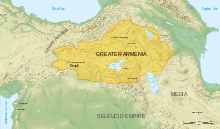
Xenophon mentions an Armenian king named Tigranes in his Cyropaedia. He was an ally of Cyrus the Great with whom he hunted. Tigranes paid tribute to Astyages. His elder son was also named Tigranes. Upon the outbreak of hostilities between the Medes and Babylonians, Tigranes had renounced his treaty obligations to the Medes. As a successor of Astyages, Cyrus demanded to be paid the same tribute. Strabo corroborates this in his Geography (xi.13.5). In 521 BC, with the disturbances that occurred after the death of Cambyses and the proclamation of Smerdis as King, the Armenians revolted. Darius I of Persia sent an Armenian named Dâdarši to suffocate the revolt, later substituting him for the Persian Vaumisa who defeated the Armenians on May 20, 521 BC. Around the same time, another Armenian by the name of Arakha, son of Haldita, claimed to be the son of the last king of Babylon, Nabonidus, and renamed himself Nebuchadnezzar IV. His rebellion was short-lived and was suppressed by Intaphrenes, Darius' bow carrier.
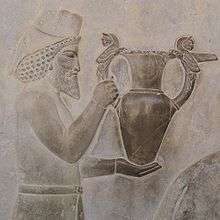

These events are described in detail within the Behistun inscription. After the administrative reorganization of the Persian Empire, Armenia was converted into several satrapies. Armenian satraps regularly intermarried with the family of the King of Kings. These satraps provided contingents to Xerxes' invasion of Greece in 480 BC. Herodotus says that the Armenians in the army of Xerxes "were armed like the Phrygians." In 401 BC Xenophon marched through Armenia with a large army of Greek mercenaries as part of the March of the Ten Thousand. Xenophon mentions two individuals by the name Orontes, apparently both Persian. One was a nobleman and military officer of high rank, belonging to the royal family; as the commander of the citadel of Sardis, he waged war against Cyrus the Younger and he tried to betray him to Artaxerxes II Memnon shortly before the battle of Cunaxa, but was taken prisoner and sentenced to death by a court martial. Xenophon's Anabasis has a detailed description of the country, where it is also written that the region near the river Centrites was defended by the satrap of Armenia for Artaxerxes II, named Orontes, son of Artasyras, who had Armenian contingents as well as Alarodians. Tiribaz is mentioned as hipparchos (vice-governor) of Armenia under Orontes, who later became satrap of Lydia.
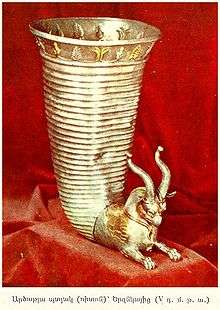
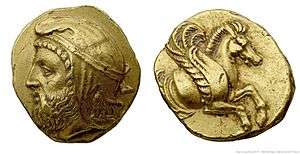
In 401 BC Artaxerxes gave him his daughter Rhodogoune in marriage. In two inscriptions of king Antiochus I of Commagene on his monument at Nemrut, an Orontes, called Aroandes (son of Artasouras and husband of Artaxerxes's daughter Rhodogoune), is reckoned, among others, as an ancestor of the Orontids ruling over Commagene, who traced back their family to Darius I. Diodorus Siculus mentions another Orontes, possibly the same, that in 362 BC was satrap of Mysia and was the leader of the Satrap Revolt in Asia Minor, for which position he was well-suited because of his noble birth and his hatred of the king. Misled by his love of power and fraud, he betrayed his fellow satraps to the king. But he revolted a second time, probably owing to his dissatisfaction with the king's rewards, and launched several attacks, which were continued in the reign of the new king Artaxerxes III Ochus. During that time he also conquered and occupied the town of Pergamum, but finally he must have become reconciled with the king. In 349 he was honored by a decree of the Athenians with civic rights and a golden wreath. Many coins were struck by him during the Satraps' Revolt in Clazomenae, Phocaea, and Lampsacus. All subsequent Orontids are his descendants. Darius III was the satrap of Armenia following Orontes, from 344 to 336 BC. An Armenian contingent was present at the Battle of Gaugamela under the command of Orontes and a certain Mithraustes. Diodorus mentions that Orontes was a friend of the Macedonian general Peucestas. Armenia formally passed to the Macedonian Empire, as its rulers submitted to Alexander the Great. Alexander appointed an Orontid named Mithranes to govern Armenia following the defeat of Orontes II. With the agreement at Babylon after Alexander's death (323 BC) Armenia was assigned to Neoptolemus, and kept it till his death in battle in 321 BC. Around 302 BC the capital was transferred from Armavir to Yervandashat by Orontes.
Starting from 301 BC Armenia is included within the sphere of influence of the Seleucid Empire, but it maintained a considerable degree of autonomy, retaining its native rulers. According to Polyaenus, in 227 BC the Seleucid rebel king Antiochus Hierax took refuge in Armenian territory governed by King Arsames, founder of the city Arsamosata. Towards the end of 212 BC the country was divided into two kingdoms, both vassal states of the Seleucids: Greater Armenia and Armenia Sophene, including Commagene or Armenia Minor. Antiochus III the Great decided to suppress the local dynasties, and besieged Arsamosata. Xerxes, the satrap of Sophene and Commagene, surrendered and implored the clemency of the king, whom he accepted as his sovereign. Antiochus gave his sister Antiochis as a wife to Xerxes; she would later murder him. Greater Armenia was ruled by an Orontid descendant of Hydarnes, the last Orontid ruler of Greater Armenia (Strabo xi.14.15); he was apparently subdued by Antiochus III the Great, who then divided the land between his generals Artaxias (Artashes) and Zariadres (Zareh), both of whom would claim descent from the Orontid family.
Orontids of Commagene

In Nemrut Dagi, opposite the statues of Gods there are a long row of pedestals, on which stood the steles of the Greek ancestors of Antiochos. At a right angle to this row stood another row of steles, depicting his Orontid and Achaemenid ancestors. From these steles the ones of Darius and Xerxes are well preserved. In front of each stele is a small altar. Inscriptions have been found on two of those altars. Antiochos expended great effort to ensure that everyone was aware that he was related to the dynasty of the King of Kings, Darius I, by the marriage of princess Rhodogune to his ancestor Orontes. The father of Rhodogune was the Persian king, Artaxerxes. In 401 BC Artaxerxes defeated his younger brother, who tried to depose him. Because of the help Artaxerxes received from Orontes—his military commander and satrap of Armenia—he gave his daughter in marriage to him. Their descendant, the Orontid Mithridates I Callinicus married Seleucid Princess Laodice VII Thea.
Orontid Kings in Armenian tradition
- Orontes I Sakavakyats (570–560 BC)
- Tigranes Orontid (560–535 BC)
- Vahagn (530–515 BC)
- Hidarnes I (late 6th century BC)
- Hidarnes II (early 5th century BC)
- Hidarnes III (middle of 5th century BC)
- Artasyrus (2nd half of 5th century BC)
Kings and Satraps
- Orontes (401–344 BC)
- Darius Codomannus (344–336 BC)
(Note: Some dates are approximate or doubtful).
- Orontes II (336–331 BC)
- Mithranes (331–323 BC)
- Perdiccas (non-dynastic) (323 BC)
- Neoptolemus (non-dynastic) (323–321 BC)
- Eumenes (non-dynastic) (321 BC)
- Mihran (321–317 BC)
- Orontes III (317–260 BC)
- Sames of Sophene (Armenia and Sophene c. 260 BC, unknown previous tenure as Satrap of Sophene)
- Arsames I (260–228 BC) (Armenia, Sophene, and Commagene)
- Charaspes (doubtful)
- Arsames II (Sophene c. 230 BC, possibly same person as Arsames I)
- Xerxes (228–212 BC) (Sophene and Commagene)
- Abdissares (212–200 BC) (Sophene and Commagene)
- Orontes IV (228–200 BC) (Armenia)
- Ptolemaeus (201 BC–163 BC) (Commagene)
- Seleucid rule (200–189 BC)
- Artaxiad rule (189–163 BC)
Orontid Kings of Commagene
- Ptolemaeus 163–130 BC
- Sames II Theosebes Dikaios 130–109 BC
- Mithridates I Callinicus 109–70 BC
- Antiochus I Theos 70–38 BC
- Mithridates II 38–20 BC
- Mithridates III 20–12 BC
- Antiochus III 12 BC–17 AD
- Ruled by Rome 17–38 AD
- Antiochus IV 38–72 AD and wife, Iotapa
Family tree
- Detailed Orontid dynasty family tree (French Wikipedia)
See also
- Artaxiad Dynasty
- Commagene
- List of rulers of Commagene
References
- David M. Lang (2008) [1983]. "Iran, Armenia and Georgia". In Ehsan Yarshater (ed.). The Cambridge History of Iran Volume 3: The Seleucid, Parthian and Sasanid Periods, Part 1. Cambridge University Press. p. 510. doi:10.1017/CHOL9780521200929.016. ISBN 9781139054942.
- Toumanoff, Cyril (1963). Studies in Christian Caucasian history. Washington D.C.: Georgetown University Press. pp. 278ff.
- (in Armenian) Tiratsyan, Gevorg. «Երվանդունիներ» (Yerevanduniner). Armenian Soviet Encyclopedia. vol. iii. Yerevan: Armenian Academy of Sciences, 1977, p. 640.
- Garsoïan, Nina (1997). "The Emergence of Armenia" in The Armenian People from Ancient to Modern Times, Volume I, The Dynastic Periods: From Antiquity to the Fourteenth Century. Richard G. Hovannisian (ed.) New York: St. Martin's Press, pp. 46-47. ISBN 0-312-10169-4.
- Babaie, Sussan; Grigor, Talinn (2015). Persian Kingship and Architecture: Strategies of Power in Iran from the Achaemenids to the Pahlavis. I.B.Tauris. p. 80. ISBN 978-1848857513.
Iranian culture deeply influenced Armenia, and Iranian dynasties ruled Armenia during several important periods, including the Orontids (c. sixth century - c. early second century BCE) and Arsacids (54-428 CE).
- Garsoian, N. (2005). "TIGRAN II". Encyclopaedia Iranica.
Tigran (Tigranes) II was the most distinguished member of the so-called Artašēsid/Artaxiad dynasty, which has now been identified as a branch of the earlier Eruandid [Orontid] dynasty of Iranian origin attested as ruling in Armenia from at least the 5th century B.C.E
- Allsen, Thomas T. (2011). The Royal Hunt in Eurasian History. University of Pennsylvania Press. p. 37. ISBN 978-0812201079.
- Sartre, Maurice (2005). The Middle East Under Rome. Harvard University Press. p. 23. ISBN 978-0674016835.
The Commagene kings claimed to be descended from the Orontids, a powerful Iranian family that had ruled the area during the Achaemenid period. They were related to the Achaemenids who had built a kingdom (...)
- Canepa 2010, p. 13.
- Drower, Margaret Stephana; Gray, Eric William; Sherwin-White, Susan Mary; Wiesehöfer, Josef. "Armenia". The Oxford Classical Dictionary. Oxford: Oxford University Press. p. 164.
In the northern bloc, it looks as though the old Iranian dynasty of the Orontids may have survived the change from Achaemenid to Seleucid rule.
- Allsen, Thomas T. (2011). The Royal Hunt in Eurasian History. University of Pennsylvania Press. p. 37. ISBN 978-0812201079.
The Orontid dynasty of Armenia (ca. 401-200), whose ruling house was of Achaemenid origin, originally administered the territory as satraps and later as independent kings.
- Payaslian, Simon (2007). The history of Armenia : from the origins to the present (1st ed.). New York: Palgrave Macmillan. p. 12. ISBN 1403974675.
- Payaslian, Simon (2007). The history of Armenia : from the origins to the present (1st ed.). New York: Palgrave Macmillan. p. 8. ISBN 1403974675.
The Ervandunis certainly stressed their Achaemenian lineage to strengthen their political legitimacy.
- Panossian, Razmik (2006). The Armenians From Kings and Priests to Merchants and Commissars. United Kingdom: Columbia University Press. pp. 35. ISBN 9781850657880.
They probably had marriage links to the rulers of Persia and other leading noble houses in Armenia.
- Schmitt 2002.
- Panossian, Razmik (2006). The Armenians From Kings and Priests to Merchants and Commissars. United Kingdom: Columbia University Press. pp. 36. ISBN 9781850657880.
The Hellenistic invasion of Persia partially influenced Armenia as well, but Persian and local Armenian culture remained the strongest element within society and the elites.
- Boumoutian, George (2006). A Concise History of the Armenian People. California: Mazda Publishers, Inc. p. 23. ISBN 1-56859-141-1.
A large portion of the population spoke Armenian, while the people of the hills had their own dialect. [...] Aramaic, the language of the imperial administration, was introduced into Armenia, where, for centuries, it continued to be used in official documents. Old Persian cuneiform, meanwhile, was used in most inscriptions.
- Manandian, Hagop (1965). The Trade and Cities of Armenia in Relation to Ancient World Trade. Armenian library of the Calouste Gulbenkian Foundation. p. 37.
- Payaslian, Simon (2007). The history of Armenia : from the origins to the present (1st ed.). New York: Palgrave Macmillan. p. 12. ISBN 1403974675.
- Tiratsyan, “Hayastane vagh hellenizmi zhamanakashrjanum,” pp. 514–15
Sources
- Canepa, Matthew (2010). "Achaemenid and Seleukid Royal Funerary Practices and Middle Iranian Kingship": 1–21. Cite journal requires
|journal=(help)CS1 maint: ref=harv (link) - Schmitt, Rüdiger (2002). "ORONTES". Encyclopaedia Iranica.CS1 maint: ref=harv (link)
Further reading
- Cyril Toumanoff. "A Note on the Orontids." Le Muséon. 72 (1959), pp. 1–36 and 73 (1960), pp. 73–106.
- (in Armenian) Hakop Manandyan. Քննական Տեսություն Հայ Ժողովրդի Պատմության (A Critical Study of the History of the Armenian People). vol. i. Yerevan: Haypethrat, 1944.
